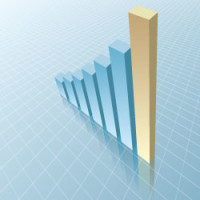The 2016 year started with ill winds for the economy. The stock market dropped more than 10 percent, oil prices crashed, holiday retail sales were so-so, and the juggernaut of China’s economy has slowed. This brings up the question “are we nearing a peak in commercial real estate values?” Commercial real estate (CRE) is a cyclical industry - just ask any developer and they will show you their scars. After five years of positive growth nationally, are we approaching a peak?
According to Dr. Glenn Mueller of Dividend Capital Research, the traditional economic model proposes four phases to the cycle- Phase I- Recovery, Phase II- Expansion, Phase III- Hypersupply, and Phase IV- Recession, we know we have been through Phase I- Recovery, as those dark years of 2009 and 2010 start to fade from memory. For most markets, the last 3-4 years have been solidly in Phase II- Expansion.
Where I have a problem with the above model is that for this cycle, there is scant evidence of Phase III- Hypersupply. In virtually every market across the country, there has been modest new construction in both industrial and office buildings. Take, for example, the inland Empire industrial market - at 500 million square feet, it is definitely a monster market- certainly a top three. Yet despite new construction starts in the 10's of millions of square feet, the vacancy rate remains very low, around 3.6 percent. Certainly not a hypersupply situation.
What I see coming instead, is a demand driven turn of the real estate cycle. Manufacturing demand is down worldwide. This is bad news for large U.S. companies, as their multinational character means that they have significant exposure to the cooling economies of China, Brazil, and Europe. The energy sector will see significant contraction in 2016, and this is not going hurt just Houston like in past recessions. Energy is a significant component of the market in Texas, Oklahoma, Colorado, Wyoming, North Dakota, and more.
Secondly, we are undergoing the most significant demographic shift of our time, as the baby boomers, the “pig in the python” of our populace, head off into retirement. This demographics is entering the age of subtraction. They are downsizing, selling off assets, don’t need three cars and two homes any more. How will this impact underlying consumer demand, which is at the heart of our economy? What about millennials? They feel as though they have been given the shaft through this last economic cycle, just ask Bernie Sanders.
While we are still awash in capital chasing real estate, for reasons that I will save for another blog, the underlying fundamentals of consumer demand look shaky at best at this point in the cycle. The retail sector will have its heart ripped out over the next five years as e-commerce becomes the preferred method of purchase. The industrial sector will see major re-design as the only way to respond to a new logistics paradigm. And industrial demand is a function of consumer demand and economic growth.
The winds of caution are in the air.






